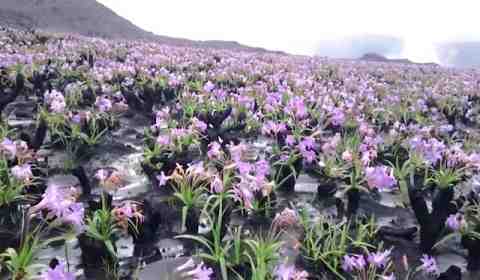Este post também está disponível em:
Português
English

Candombá or Vellozia sincorana is a typical and endemic flower of the Rupestrian Fields of the Chapada Diamantina National Park.
The Candombá, which had not bloomed for 17 years, is reborn in a recently burned area and changes the landscape.
The Candombá has bloomed again on burned tree stumps in an area devastated by a fire in Serra da Larguinha, between the municipalities of Palmeiras and Lençóis.
The images of the valley of flowers of the Candombá species that formed on the site were taken by the Bahian photographer Rui Rezende.
He was hiking with one of his sons through the Vale do Capão to reach the Cachoeira da Fumaça, the second highest waterfall in Brazil, when he came across the rare scene.
“It was a pleasant surprise. We were heading towards Cachoeira da Fumaça from below. I was taking my son once again on this trail with friends when I came across that scene on the way up the trail.
In nature photography, we always come across impressive scenes. And this time was no different, “he said.
According to botanist Abel Augusto Conceição, from the State University of Feira de Santana (Uefs), the flowers of the Candombá species depend on fire to bloom.

Candombá in Chapada Diamantina
In the last three months of last year alone, fires devastated 51,000 hectares in the Chapada Diamantina, according to the Bahia Environment Secretariat.
Of the total, 15,000 hectares affected by the flames are within the National Park, which is an environmental preservation area that covers six municipalities. The outbreaks were only completely extinguished after rains in January.
“This exuberant and wonderful bloom is an extremely rare scene. This candombá population bloomed 17 years ago and only now has it bloomed again. It depends on fire, and only blooms with fire. So, if there is no fire, there is no flower. It only exists within the Chapada National Park.
In the case of Candombá, it blooms 30 days after the fire. In addition, the amount of nectar is fabulous, “says the expert.
Throughout his career, Rui Rezende says he has photographed the Chapada Diamantina several times, including during the fires caused by human action last year.
“The trees burn completely. The black stump remains, and anyone who looks will be absolutely sure that that plant is dead. It’s a fantastic scene. It’s a natural thing. Man comes with fire, and nature comes with flowers”, he comments.
Chapada Diamantina Tourism and Travel Guide



















